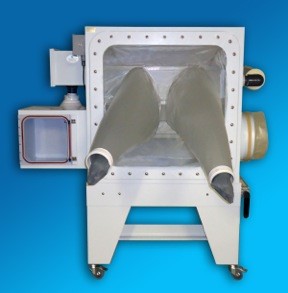
What it Takes To Start a Germ-Free Gnotobiotic Isolator Colony: Step #2
The most obvious and arguably most critical piece of equipment in the colony is the isolator. The decision on isolator features is driven by the demands of the project at hand, including animal sourcing and the supplies involved in the research.
There are three basic types of isolators: rigid, flexible film and semi-rigid/ flexible front. As a manufacturer, I am frequently asked which style is best. My simple answer is: it’s mostly personal preference and previous experience. To expand on that, whatever can be done in one type can be done in the other two types. I only manufacture semi-rigid type isolators, but it would be dishonest to say only one style can work!
More important than the chamber type is the port or ports. Some of my clients are using a technique I’ll call small batch sterilization or packs. In this method, supplies like food & bedding are wrapped much like a surgical pack. They are covered in a double layer of surgical cloth, prepared and autoclaved. In this case a large rectangular port is particularly helpful.
A second method is the tried-and-true autoclave cylinders. In this case a 12” or 18” diameter round port will usually suffice. An alternate method is to use irradiated food and bedding. Irradiated packages work most efficiently in a rectangular port. However, that comes with a caveat — typical commercial irradiation is not sufficient for germ-free.
Perhaps the most compelling reason for a round port is the use of germ-free animal (mouse) shippers like those used by Taconic, which require a round port to transfer animals directly into the isolator. Alternatively, transfers can be made in pre-sterilized containers and a clean bench.
For years I was a proponent of rectangular ports. However, with the renewed focus on germ-free mice I’ve modified my view. Why be limited to one port? Why not have one rectangular and one round? A current trend and a majority of the isolators built by Park Bio for germ-free/ gnotobiotic use now have dual ports. Thus far this is unique to the semi-rigid design.
*There are several useful recently published text on this topic. I highly recommend “Gnotobiotics” by Trenton Schoeb and Kathryn Eaton published by Academic Press, 2017. There is an extremely useful chapter by Betty Theriault on starting a germ-free colony. Another is “Gnotobiotic Mouse Technology” by Chriss Vowles, Natalie Anderson, Kathryn Eaton CRC Press, 2016. Trenton’s text gives extensive coverage of both semi-rigid and flexible film isolators. Chris’ focuses on flexible film, but there is also a wealth of other information in his excellent text!
Keep in mind although some techniques in the references are geared towards either semi-rigid or flexible film, nearly all can be adapted for use in whatever isolator you choose!
I have avoided mentioning IVC (individual ventilated cages). This is a viable solution for short term (less than 45 days) housing of gnotobiotic animals and/ or mono-associated animals. However, it is my opinion that they should never be considered for a foundation/ breeding colony of germ-free animals.
Directly related to the isolator themselves, and in fact a key part of what makes up a modern isolator, are the HEPA filters or in some cases a wrapped filter. The old test method of filtration has been without substantial change since the 1960’s. This method involves a filter body, consisting of a metal perforated core with filter media wrapped around the core, over the perforations, and held in place with clamps/tape.
The most common filter media was for years a fiberglass (pink) media that looks a bit like household insulation. In recent years, a substitute/ replacement for the fiberglass media has been a non-woven synthetic media often referred to as DW4. Wrap filters are not HEPA. They are probably 95-98% efficient at .3 microns. Most commonly wrap filters are validated by whether they are properly autoclaved or in place. Rarely are they validated by particle count.
The alternative to wrap filters are cartridge HEPA, which have around since the 1980’s and used in a variety of application both related to and unrelated to laboratory animals. The advantage with cartridge HEPA is they can (and should) be 100% tested to I. E.S.T. standards. They are true HEPA and not dependent on the technique of the person preparing the core wrapping. Generally the wrap filter is considered by most to be the least expensive. That school of thought can easily be proved wrong if you apply sound cost accounting principles. To break down the steps of both methods:
Wrapped Type
- Source and order the DW4 media
- Inventory the necessary tape, Mylar and media
- Cut the media to length, first though determine 3 wraps or 4
- Follow the ten-step set up procedure outline by * Chriss Vowles (see the reference in the text above).
- Autoclave
- Install in place on the sterilized isolator
- Validate
(at least 17 steps and hours of direct labor)
Cartridge Type
- Source and order
- Install on isolator
- Sterilize in place at the same time the isolator body/ chamber
- Validate
(Minimal labor)
This covers only the most expensive items needed. For a more complete list of required equipment, please see the textbooks I recommend earlier in this blog installment.
